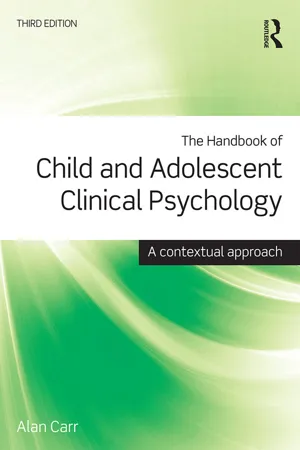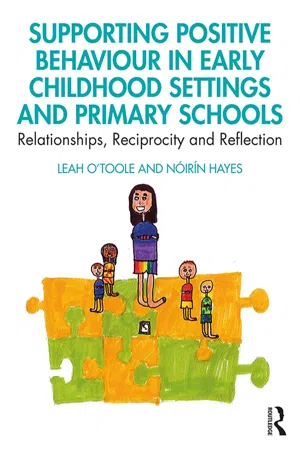Psychology
Environmental Factors in Development
Environmental factors in development refer to the external influences that impact an individual's growth and behavior. These factors can include family dynamics, socioeconomic status, cultural influences, and physical surroundings. Environmental factors play a significant role in shaping an individual's cognitive, emotional, and social development.
Written by Perlego with AI-assistance
5 Key excerpts on "Environmental Factors in Development"
Learn about this page
Index pages curate the most relevant extracts from our library of academic textbooks. They’ve been created using an in-house natural language model (NLM), each adding context and meaning to key research topics.
- eBook - ePub
Exploring Developmental Theories
Toward A Structural/Behavioral Model of Development
- Frances Degen Horowitz(Author)
- 2014(Publication Date)
- Psychology Press(Publisher)
Werner, 1979 ). Vygotsky placed particular emphasis on language as shaping the basic structure of the child's thinking. Symbolic activity, as the child develops, has an organizing function and is one of the fundamental sources for shaping new forms of behavior. Thus, culture is depicted in terms of patterns of environment that become part of internal representations through the development of symbolic systems. Vygotsky developed a particular view with respect to behavioral transformation and development in relation to learning. He considered learning to be an extremely important variable, but not synonymous with development. Learning stimulates mental development, which stimulates developmental processes that would not otherwise occur. The environmental (i.e., cultural) context essentially defines the learning that will occur, its timing and the forms by which development will be expressed in behavioral patterns.This view of culture makes culture the most pervasive factor in the organizational structure of the environment. It includes things that range from the arrangement of the physical environment into which the child is born to the socio-historical context that defines, regulates, and elaborates the learning opportunities available to the child. It is not clear what level or levels of analysis will be most useful for revealing the patterning of the environment as culture nor whether various dimensions of cultural experience differentially influence different domains of development and/or periods of development. The human species has a prolonged period of infancy in which the infant is extremely dependent on the social system and on interpersonal relationships. The early cultural context of development may thus be particularly effective and important in shaping the basic cognitive and emotional structures that subsequently organize the child's relationship with the environment and that influence the manner in which the environment can affect the child. Culture may therefore represent a kind of overriding dimension of environmental experience as a component in the transactional model. It can only be modified gradually and over long periods of time. In the modern era, however, rates of cultural change have increased vastly over previous periods of history. This raises the intriguing possibility that the instability of the cultural dimension during such times changes the relationship of culture and development. Additionally, if children grow up in functionally conflicting cultural contexts their developmental progress may be adversely affected. Alternatively, such pluralism of cultural experience, if the conflicting elements are not developmentally destructive, may define new cultural composites that result in new or different forms of behavior. The effect of these kinds of variables on a child's development probably is partially dependent on the timing of their occurrence with respect to the developmental stage of the child in different domains. - Donna Couchenour, J. Kent Chrisman(Authors)
- 2016(Publication Date)
- SAGE Publications, Inc(Publisher)
Determinants of child development include the biological endowment of the child as determined by the child’s genetic makeup, the culture, and environment in which the child lives. Together, these forces interact to create potentials or pathways along which the child will develop. Social determinants of child development refer to the family’s access to income, goods, and services that include health care, education, employment, and safe homes and neighborhoods. Environmental determinants include the physical, chemical, and biological factors external to people that impact their development. Access to clean air and water and safe and healthy workplaces, homes, and communities determine potential pathways for healthy development.Biological Determinants
Biologically based determinants of development are laid within the genetic material of each child and are affected by the quality of prenatal care and health of the mother prior to birth to set the parameters for physical, social, emotional, and cognitive development. However, physiological, psychosocial, and environmental influences further affect the child’s potential development. For example, physiological development is dependent on securing nutritional foods to support bodily growth and functioning that leads to health. To that end, the infant must be able to communicate and receive nutrition from the mother. As the infant receives nutrition from the mother and the mother responds with appropriate nurturing attention during feeding, this joint participation can lead to healthy attachment that supports brain functioning as well as behavioral adaptation for participation within the family and community.Healthy attachment to a primary caregiver is a developmental determinant that has been linked to the child’s overall physical health and well-being, to cognitive and language development, and to social-emotional development. Affecting healthy attachment is the goodness of fit between the child’s temperament and that of the primary caregiver. For the mother to bond with her child, she must sense that her efforts to respond to her child and to elicit positive attention are met with a child’s positive attention returned to her. The ways that mother and child contingently initiate and respond to one another support the development of healthy attachment bond between them. As the nurturing relationship is created and sustained, there are increased opportunities for playful physical interactions, social exchanges involving language, and cognitive stimulation. The accompanying sense of well-being leads to the development of the infant’s mental and emotional health, creating a pathway for optimal child development. However, when the child is not responsive to the mother’s attempts to soothe or interact or the mother is incapable of positive interactions because of stress, depression, or ill-health, then the formation of the attachment bond is at risk. As a result, infants may become withdrawn or anxious, unable to develop trusting relationships that allow them to venture out beyond the immediate care of the parent to explore environments and develop healthy relationships with others. With such a pathway and without intervention, there are significant risks for physical and mental health outcomes that can extend into adulthood.- eBook - ePub
The Language of Winnicott
A Dictionary of Winnicott's Use of Words
- Jan Abram(Author)
- 2018(Publication Date)
- Routledge(Publisher)
Environment1 The impact of the environment on human development 2 The analytic setting—a holding environment 3 Psychosis—an environmental deficiency disease 4 Psychotic anxiety 5 Impingement 6 Fear of breakdown 7 “We are poor indeed if we are only sane” 8 Father—the indestructible environment Winnicott’s theory of emotional development lays an emphasis on the psychic environment and its responsibility for the emotional health of the infant.The first environment for the infant is mother, and at the beginning they are merged together in an environment–individual set-up.The emotional environment cannot be held totally responsible for what becomes of the infant in terms of his mental health; it can only provide a spectrum of available experience: at the good end it is facilitating, at the other it is damaging.The facilitating environment enables the individual to take the opportunity to grow and will usually lead to health, whereas the emotional environment that fails, particularly in the beginning, is more likely to lead to mental instability and ill health.1 The impact of the environment on human developmentPsychoanalytic literature makes reference to the mother’s role in relation to her infant, but, in the main, until around 1950, the theoretical thrust had been very much on the individual and his inner world. The impact of the environment on the mental health of the individual had not really been accorded the importance it has since held in analytic theory, and Winnicott’s contribution is seminal.In 1942, Winnicott found himself jumping up in a meeting and saying, “There’s no such thing as a baby!” It was, for him, a moment of true discovery, which he relates ten years later, in his paper, “Anxiety Associated with Insecurity”, presented to the British Psycho-Analytical Society in 1952. The individual was from then on no longer a unit, but an environment–individual set-up—the nursing couple.. . . if you show me a baby you certainly show me also someone caring for the baby, or at least a pram with someone’s eyes and ears glued to it. One sees a nursing couple . . . before object relationships the state of affairs is this: that the unit is not the individual, the unit is the environment–individual set-up. The centre of gravity of the being does not start off in the individual. It is in the total set-up. - eBook - ePub
The Handbook of Child and Adolescent Clinical Psychology
A Contextual Approach
- Alan Carr(Author)
- 2015(Publication Date)
- Routledge(Publisher)
Ingram & Price, 2010 ). These biological and psychological predisposing factors will be considered in turn.Genetic factors
Twin and adoption studies show that genetic factors influence the development of many psychological characteristics such as temperament, major personality traits and intelligence (Maltby et al., 2013 ). These characteristics are about 50% heritable. Genetic factors also play a role in the aetiology of many psychological problems (Rutter, 2006 ). The mechanism of influence for both broad psychological characteristics and specific psychological problems is usually polygenetic. With the exception of some disorders (e.g. Down syndrome), genetic factors determine the development of specific psychological problems through their influence on broader psychological characteristics such as temperament. Current evidence does not support the view that most childhood psychological problems are unalterably genetically determined. Rather genetic factors render children vulnerable to developing psychological problems in certain environmental contexts.Pre-natal and peri-natal complications
Pre-natal intrauterine adversities and peri-natal complications may predispose children to developing psychological difficulties. The intrauterine environment may entail hazards which compromise the healthy development of the foetus (Rutter & Casaer, 1991 ; Zimmerman & Connors, 2011 ). Maternal age, blood-type incompatibility, malnutrition, smoking, alcohol use and drug use are among the factors that may negatively impact on the intrauterine environment. For example, the progeny of women who abuse alcohol while pregnant may develop foetal alcohol syndrome, a condition characterized by microcephaly, intellectual disability and craniofacial anomalies (Memo et al., 2013 ). Infections such as rubella, syphilis and AIDS may be transmitted from the mother to the foetus. Often infants who have developed in a hazardous intrauterine environment have low birth weight (less than 4.5 lbs. or 2,000 grams) or their size in relation to their gestation period is sufficiently below average to be described clinically as small-for-dates - eBook - ePub
Supporting Positive Behaviour in Early Childhood Settings and Primary Schools
Relationships, Reciprocity and Reflection
- Leah O'Toole, Nóirín Hayes(Authors)
- 2019(Publication Date)
- Routledge(Publisher)
Bronfenbrenner’s model of human development provides an impetus for responding to contemporary understandings of child development and behaviour. Changing educational practice to incorporate this new knowledge, based on scientific understandings of development, is not an easy task. Such transformation rests with all those concerned with quality educational practice and requires ongoing reflection and a commitment to learning and change. As Bronfenbrenner (2005, p. XXVII) puts it:Human beings create the environments that shape the course of human development. Their actions influence the multiple physical and cultural tiers of the ecology that shapes them, and this agency makes humans – for better or for worse – active producers of their own development.Educators play a central role in building and developing an environment that motivates children to interact with each other, with the participating adults and with the objects within their space. These experiences support children in becoming confident and competent communicators who behave positively in their educational settings. An important aspect of the design of learning environments is that they can help to promote positive learning and behavioural dispositions in children. As adults we have a powerful role in facilitating this development through providing quality learning environments that encourage children to develop positive, generative dispositions of curiosity, persistence, responsiveness, the tendency to initiate and engage in activity (alone or with others), and inhibit the more disruptive dispositions of impulsiveness, explosiveness, distractibility or at the opposite pole, apathy, inattentiveness, unresponsiveness, lack of interest in one’s surroundings, feelings of insecurity or shyness.Key concepts within this chapter for educational practice- Children’s behaviour develops from a complex mix of influences at proximal (close) and distal (far away) levels. It is impossible to understand a child’s behaviour out of the context in which it develops.
- Relationships are crucial for the development of positive behaviour. Bronfenbrenner thought that relationships were so important that he called them ‘the engines of development’. He named them ‘proximal processes’.




